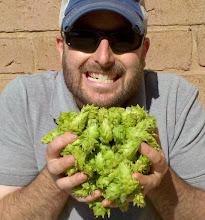As far as competition is concerned, luckily I don't really need to follow any specific guidelines. Quoted below is the category guidelines for smoked beer. Since this homebrew recipe does not follow any classic styles, I can easily blanket the underlying style as a "Porter".
IF THIS BEER IS BASED ON A CLASSIC STYLE (E.G., ROBUST PORTER) THEN THE SPECIFIC STYLE MUST BE SPECIFIED. CLASSIC STYLES DO NOT HAVE TO BE CITED (E.G., “PORTER” OR “BROWN ALE” IS ACCEPTABLE). THE TYPE OF WOOD OR OTHER SOURCE OF SMOKE MUST BE SPECIFIED IF A “VARIETAL” CHARACTER IS NOTICEABLE.
On another note, I've been having a great time utilizing the Wort Chiller with Recirculation Combination. With cooler weather in San Diego, there has also been a significant drop in tap water temperatures. Today, I was able to reduce a boiling wort to 63°F in 20 minutes using slightly less than 20 gallons of water (I use this hot/warm/cool effluent for washing and rinsing). At the end of chilling, I pump out the wort rather quickly to a carboy. Check it:
 |
| After chillindamos, the March Pump and recirculation arm quickly transfer the wort to a carboy. |
 |
| Pumping wort is not only fast, it seems to do a fairly decent job of aerating as well. |
Smoked Porter
BJCP 22B. Other Smoked Beer
5 Gallons, All Grain, Single Infusion Mash, 90 Minute Boil
9 lbs. Domestic 2-Row
2 lbs. Red Wheat
2 lbs. German Rauch Malt
0.7 lbs. UK Chocolate Malt
0.75 lbs. Crystal 20
0.25 lbs. Crystal 60
4.5 oz. Carafa II
2.5 oz. Dark British Crystal
Single Infusion Mash
(1 qt./lb. raised to 167°F)
Saccharification Rest at 148-150°F for 70 minutes
Fly-sparged 5.5 gallons at 170°F
1.5 oz. Homegrown Chinook 60 min.
0.75 oz. Spalt 20 min.
1 Whirlfloc Tab 20 min.
0.5 oz. Spalt 10 min.
White Labs WLP001 California Ale Yeast 2 vials (thanks Kara)
OG: 1.063 @ 62°F
FG: 1.013 @ 66°F
ABV: 6.7%



















